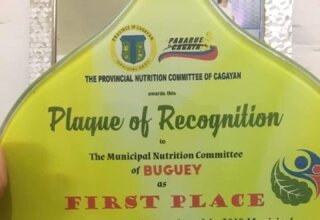-
PNP scores Against Illegal Drugs
TUGUEGARAO CITY, Cagayan—Police Regional Office 2 (PRO2) in its intensified campaign again… -
Family’s cooperation ‘crucial’ in solving Fr. Ventura’s killing – police
TUGUEGARAO CITY, Philippines- The Cagayan provincial police said the family’s partic… -
Cagayan may lose millions for road projects yet again
TUGUEGARAO CITY, Philippines- The province of Cagayan is at risk losing almost P90 million…
Load More Related Articles
-
Uphill Nutrition Climb For Buguey
The local government unit was invited to attend an awarding ceremonies on nutrition in 201… -
CEZA celebrates October fest with first-ever music festival in Sta. Ana
STA. ANA, Cagayan – Expect local bands to out-play each other as the Cagayan Economic Zone… -
Cagayan teacher choreographs Ibanag’s Dudul as teaching strategy
TUGUEGARAO CITY, Cagayan – A secondary school teacher from Linao National High Schoo… -
Duterte oks nomination of ex-Tuguegarao vice mayor as CEO of Devp’t Academy of the Philippines
TUGUEGARAO CITY, Philippines- President Rodrigo Roa Duterte has approved the nomination of… -
King of Ibanag Rice Cakes
When it’s Lent, it must be rice cake cooking time for the Ibanags. Forever a sweet-toothed…
Load More By Benjamin De Yro
-
Breaking the stigma, from the shadows to the spotlight
Art for arts’ sake! A portal to “universe of paintings” is two hours away from the regiona… -
The Inner Sanctum of Ilagan
The welcome arch tells it all. You are about to enter a city dubbed as the Corn Capital of… -
Turning Japanese in Ilagan
Little girls in colorful Japanese national dress, make-up and hair styles and holding thei… -
Uphill Nutrition Climb For Buguey
The local government unit was invited to attend an awarding ceremonies on nutrition in 201… -
Conservation Efforts for Cagayan’s Siging
Caloy Taguinod, 67 years old and a resident of Lagum, Penablanca used to bring dried eels …
Load More In Features
Comments are closed.
Check Also
Breaking the stigma, from the shadows to the spotlight
Art for arts’ sake! A portal to “universe of paintings” is two hours away from the regiona…


















